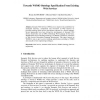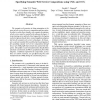JODS
2008
14 years 6 months ago
2008
Joining up services in e-Government usually implies governmental agencies acting in concert without a central control regime. This requires to the sharing scattered and heterogeneo...
IS
2006
14 years 6 months ago
2006
This paper introduces a method for automatic composition of Semantic Web services using Linear Logic (LL) theorem proving. The method uses a Semantic Web service language (DAML-S)...
BMCBI
2007
14 years 6 months ago
2007
Background: Traditional HTML interfaces for input to and output from Bioinformatics analysis on the Web are highly variable in style, content and data formats. Combining multiple ...
CIIA
2009
14 years 7 months ago
2009
Semantic Web Services (SWSs) aim to improve the possibilities for automated discovery, composition and invocation of Web Services by providing ontology-based service descriptions e...
ICWS
2004
IEEE
14 years 7 months ago
2004
IEEE
This paper introduces a method for automatic composition of Semantic Web services using Linear Logic (LL) theorem proving. The method uses Semantic Web service language (DAML-S) f...
ICWS
2007
IEEE
14 years 8 months ago
2007
IEEE
The semantic web promises to bring automation to the areas of web service discovery, composition and invocation. In order to realize these benefits, rich semantic descriptions of...
SERVICES
2010
14 years 8 months ago
2010
In recent years, a number of approaches to semantic Web service matchmaking have been proposed. Most of these proposals are based on discrete and thus relatively coarse Degrees of...
EON
2008
14 years 8 months ago
2008
Abstract In this paper we present how Semantic Web Service technology can be used to overcome process and data heterogeneity in a B2B integration scenario. While one partner uses s...
104
click to vote
EON
2008
14 years 8 months ago
2008
Abstract. This paper describes how semantic bridges realized in terms of rulebased ontology mappings can be incorporated into BPEL processes. The approach is explained by applying ...
ESWS
2008
Springer
14 years 8 months ago
2008
Springer
One of the crucial reasons for adding semantic descriptions to Web services is to enable intelligent discovery, removing the need for a human to manually search and browse textual ...








